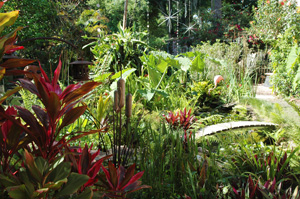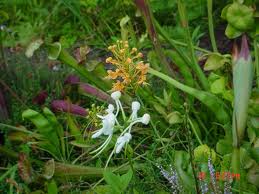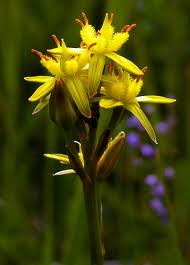





A bog garden can make the most wonderful adjunct to a pool or streamside, not only being pleasing to the eye, but also providing an opportunity to grow a wide range of fascinating plants. Some plants that often struggle in the herbaceous border flourish when provided with a constant supply of moisture, for example astilbes, hostas and ligularias.
 If you have a naturally boggy area in the garden, you may be keen to turn it into a bog garden. However, do not begin work upon such a project until you are absolutely certain that it is boggy all year round. Many areas that are damp through autumn and spring, and wet during winter, dry out completely in the summer months. Often, such wet areas are the result of poor or disrupted land drainage, which creates a wet patch. Sometimes wet areas are fed by a spring, in which case they may well be permanent, but subject to change if the ground is cultivated too deeply, so take great care.
If you have a naturally boggy area in the garden, you may be keen to turn it into a bog garden. However, do not begin work upon such a project until you are absolutely certain that it is boggy all year round. Many areas that are damp through autumn and spring, and wet during winter, dry out completely in the summer months. Often, such wet areas are the result of poor or disrupted land drainage, which creates a wet patch. Sometimes wet areas are fed by a spring, in which case they may well be permanent, but subject to change if the ground is cultivated too deeply, so take great care.
One of the major difficulties with a natural boggy area is ridding it of pernicious weeds. These normally comprise reeds and rushes of inelegant growth with a tremendous ability to seed freely, or spread by means of underground rootstocks. They also have waxy foliage that repels herbicides, leading to more frequent applications. Hand weeding will be tedious and, because of the boggy nature of the soil, it will often be impossible to completely remove invasive species like couch grass. Disturbing boggy ground also causes seed that has been lying dormant to germinate freely. So the natural boggy area is not the easiest to bring under control.
However, by the persistent use of a systemic herbicide in which glyphosate is the active ingredient, weed cover can be cleared up. For the best effect, the chemical should be applied when the weeds are growing actively with plenty of leaf to accept the spray. This will be absorbed and taken right down through the sap stream to the roots, killing the plants completely. Several applications will be needed, not only to ensure proper absorption by established plants, but also to cope with dormant seeds, which inevitably sprout when competing weed cover is removed.
Systemic herbicides do not act quickly, so if nothing much happens during the first couple of weeks, do not be concerned, especially if the weather is cool. Resist the temptation to seek a rapid result by burning off the foliage with a contact weedkiller. This will reduce the effectiveness of the systemic herbicide and may result in incomplete destruction, particularly of extensive underground root systems. Once heavy weed cover has been killed off, remove it by raking vigorously with a spring-tined rake. Then cultivate the ground prior to planting by digging it over with a garden fork, adding plenty of organic material at the same time.
If you do not have a natural boggy area in your garden, it is a relatively simple task to construct one as an extension to a pool when it is being built. Not only will bog garden plants look appropriate in this setting, but they will also provide a link with the surrounding garden and a more natural means of disguising the harsh edge of the pool.
The inclusion of a bog garden as an integral part of a pool must be planned well in advance if it is to be a success, for it needs to be part of the pool’s actual construction. The most effective method of construction is to use a flexible liner. The excavation should form a shallow ‘pool’, with a uniform depth of between 30 and 45cm (12 and 18in), alongside the main water feature, being dug out at the same time. Scour the area of the bog garden for sharp stones and sticks that may puncture the liner and spread a layer of damp bricklayers’ sand over the soil in the same manner as the pool itself. Although there will be no standing water in the boggy area, as in the pool, preventing leaks is just as important, as they might allow the soil to dry out.
Once the liner has been installed, the area between the pool and the bog garden should be clearly defined by a loose-laid retaining wall of bricks or stones. This will keep the soil out of the pool while allowing water to percolate through to the soil and create boggy conditions. Ideally, the soil in the bog garden should be at least 5cm (2in) above water level. It should be a heavy mixture incorporating a generous amount of well rotted organic matter.
If irregularly shaped stones are used to provide a barrier between the pool and bog garden, there is a chance that soil may spill through into the former. To prevent this, stretch fine garden netting across the inner face of the stones. This should be barely discernible when in place.
Adding a bog garden to an existing pool is more difficult without having an adverse effect on the structure. The only time that this is really practical is when a pre-formed pool has been installed and a similar pre-formed shape is used as a bog garden, the two being linked by discreetly adding a short length of piping. Where a liner has been used, a much better job can be achieved if the old liner is removed, the excavation enlarged to encompass the boggy area, and a new larger liner purchased. In all other cases, it is preferable to build an independent bog garden. For all practical purposes, this will be self-contained, but to the uninformed observer, it may appear to be an integral part of the pool feature.
When creating an independent bog garden, the general rules that apply to building a normal pool should be observed. A pool liner is the easiest and most versatile form of construction, although both concrete and pre-formed pools can be used successfully.
The most important practical aspect of the boggy area’s construction is achieving the correct depth.
 Unlike a bog garden that forms part of a pool complex and is kept damp by the pool water, an independent feature must retain its own moisture as much as possible. Since it will be isolated from the surrounding ground, it will not benefit from the natural percolation of moisture through the soil and may dry out rapidly. In view of this, a minimum depth of 60cm (24in) is recommended. An extensive boggy area could probably be a little shallower, but for the most part, the deeper it is, the better. The depth should be the same across the entire site.
Unlike a bog garden that forms part of a pool complex and is kept damp by the pool water, an independent feature must retain its own moisture as much as possible. Since it will be isolated from the surrounding ground, it will not benefit from the natural percolation of moisture through the soil and may dry out rapidly. In view of this, a minimum depth of 60cm (24in) is recommended. An extensive boggy area could probably be a little shallower, but for the most part, the deeper it is, the better. The depth should be the same across the entire site.
The size of the excavation will depend upon the material being used in its construction. Despite the fact that only wet soil is involved, it would still be prudent to allow for up to 15cm (6in) of concrete if this material is to be employed.
When a pre-formed pool is used as a bog garden, it is just as important to be able to support the weight of someone walking in it and, as such, it must be supported as completely underneath as a conventional pool.
A pool liner is installed in exactly the same way for an independent bog garden as for a pool, taking the same precautions to prevent puncturing. However, it need not be of PVC or rubber; polythene sheeting is perfectly adequate. When completely covered by soil, it does not stiffer from exposure to ultraviolet light and subsequent degradation, as it would do in a pool. Also, as the liner does not show, any wrinkles or creases in it will not be evident. It will not be quite as easy to mould to the excavation as the other types of liner, but it is important to fill it properly, ideally with a little slack. If stretched too much in the corners, it may burst under the weight of soil.
A sufficient margin of liner should be allowed around the edges so that it can be secured satisfactorily. If you intend growing grass around the bog garden, you can cover the edge of the liner with soil and lay turf over the top. Make sure that the liner is not buried so deeply that moisture can escape from the upper layer of soil in the bog garden, effectively creating a leak. Remember that an independent bog garden acts very much like a pond and will require constantly moistening with water. Any escape of moisture may actually have an adverse effect on nearby plants.
If the bog garden is adjacent to other cultivated areas, the edge of the liner must be secured in a different manner. Where it has a straightforward formal outline, lengths of tim can be used, the liner being wrapped around these and secured by nailing on wooden laths. The wood and liner can :hen be buried just beneath the surface of the surrounding garden. The liner will protect the wood from rotting, while the whole arrangement makes finding and securing the edge of the liner a simple matter if major maintenance tasks or alterations are required.
Where a more informal outline is desired, the same effect can be achieved with bricks. This is a little more time consuming, since each brick must be wrapped under the edge of the liner and positioned against its neighbour, the entire edge then being buried, but it does allow great flexibility in shape.
 Since many of the most popular bog garden plants are quite large, there is a common misconception that you can only have a bog garden if you have plenty of space. This is not so, for a very acceptable bog garden arrangement can be created in a wooden tub or sink buried in the ground. Indeed, there is an advantage to this kind of feature, as such containers are much easier to keep permanently wet.
Since many of the most popular bog garden plants are quite large, there is a common misconception that you can only have a bog garden if you have plenty of space. This is not so, for a very acceptable bog garden arrangement can be created in a wooden tub or sink buried in the ground. Indeed, there is an advantage to this kind of feature, as such containers are much easier to keep permanently wet.
When planting a miniature bog garden, use plants of smaller scale, such as the lovely little Primula rosea and the bog asphodel (Narthecium ossifragum). Alternatively, you could devote the container to an individual vigorous species like Primula florindae, using it as a focal point or feature.
Copyright © www.100flowers.win Botanic Garden All Rights Reserved